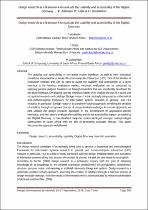 ResearchSpace
ResearchSpace
Design research as a framework to evaluate the usability and accessibility of the digital doorway
JavaScript is disabled for your browser. Some features of this site may not work without it.
- ResearchSpace
- →
- Research Publications/Outputs
- →
- Conference Publications
- →
- View Item
| dc.contributor.author |
Adebesin, F

|
|
| dc.contributor.author |
Kotzé, Paula

|
|
| dc.contributor.author |
Gelderblom, H

|
|
| dc.date.accessioned | 2012-01-04T11:03:43Z | |
| dc.date.available | 2012-01-04T11:03:43Z | |
| dc.date.issued | 2011-09 | |
| dc.identifier.citation | Adebesin, F, Kotzé, P and Gelderblom, H. 2011. Design research as a framework to evaluate the usability and accessibility of the digital doorway. Design, Development & Research Conference, Cape Peninsula University of Technology, Cape Town, 26-27 September 2011 | en_US |
| dc.identifier.uri | http://hdl.handle.net/10204/5424 | |
| dc.description | Design, Development & Research Conference, Cape Peninsula University of Technology, Cape Town, 26-27 September 2011 | en_US |
| dc.description.abstract | The usability and accessibility of interactive system interfaces, as well as their evaluation constitutes important focus areas of human-computer interaction (HCI). One of the families of evaluation methods that can be used to assess the usability and accessibility of a given interface is the heuristic evaluation method. Heuristic evaluation can be conducted by applying general purpose heuristics or through heuristics that are specifically developed for the given interface. Developing specific heuristics hardly ever involves the use of a sound and recognized research methodology. Design research is increasingly being used as a theoretical and methodological framework for information systems research in general, and HCI research in particular. Design research is a problem-solving approach, involving the creation of artefacts through a rigorous process of design-evaluate-redesign. In a novel approach, the authors utilized the design research paradigm in the development of application-specific heuristics, and then also evaluated the usability and direct accessibility support provided by the Digital Doorway, a non-standard computer system deployed amongst underprivileged communities in South Africa with the aim of promoting computer literacy. This paper discusses the approach they followed. | en_US |
| dc.language.iso | en | en_US |
| dc.relation.ispartofseries | Workflow request;7776 | |
| dc.subject | Design research | en_US |
| dc.subject | Digital Doorway | en_US |
| dc.subject | Heuristic evaluation | en_US |
| dc.subject | Human-computer interaction | en_US |
| dc.subject | Interactive system interfaces | en_US |
| dc.title | Design research as a framework to evaluate the usability and accessibility of the digital doorway | en_US |
| dc.type | Conference Presentation | en_US |
| dc.identifier.apacitation | Adebesin, F., Kotzé, P., & Gelderblom, H. (2011). Design research as a framework to evaluate the usability and accessibility of the digital doorway. http://hdl.handle.net/10204/5424 | en_ZA |
| dc.identifier.chicagocitation | Adebesin, F, Paula Kotzé, and H Gelderblom. "Design research as a framework to evaluate the usability and accessibility of the digital doorway." (2011): http://hdl.handle.net/10204/5424 | en_ZA |
| dc.identifier.vancouvercitation | Adebesin F, Kotzé P, Gelderblom H, Design research as a framework to evaluate the usability and accessibility of the digital doorway; 2011. http://hdl.handle.net/10204/5424 . | en_ZA |
| dc.identifier.ris | TY - Conference Presentation AU - Adebesin, F AU - Kotzé, Paula AU - Gelderblom, H AB - The usability and accessibility of interactive system interfaces, as well as their evaluation constitutes important focus areas of human-computer interaction (HCI). One of the families of evaluation methods that can be used to assess the usability and accessibility of a given interface is the heuristic evaluation method. Heuristic evaluation can be conducted by applying general purpose heuristics or through heuristics that are specifically developed for the given interface. Developing specific heuristics hardly ever involves the use of a sound and recognized research methodology. Design research is increasingly being used as a theoretical and methodological framework for information systems research in general, and HCI research in particular. Design research is a problem-solving approach, involving the creation of artefacts through a rigorous process of design-evaluate-redesign. In a novel approach, the authors utilized the design research paradigm in the development of application-specific heuristics, and then also evaluated the usability and direct accessibility support provided by the Digital Doorway, a non-standard computer system deployed amongst underprivileged communities in South Africa with the aim of promoting computer literacy. This paper discusses the approach they followed. DA - 2011-09 DB - ResearchSpace DP - CSIR KW - Design research KW - Digital Doorway KW - Heuristic evaluation KW - Human-computer interaction KW - Interactive system interfaces LK - https://researchspace.csir.co.za PY - 2011 T1 - Design research as a framework to evaluate the usability and accessibility of the digital doorway TI - Design research as a framework to evaluate the usability and accessibility of the digital doorway UR - http://hdl.handle.net/10204/5424 ER - | en_ZA |





